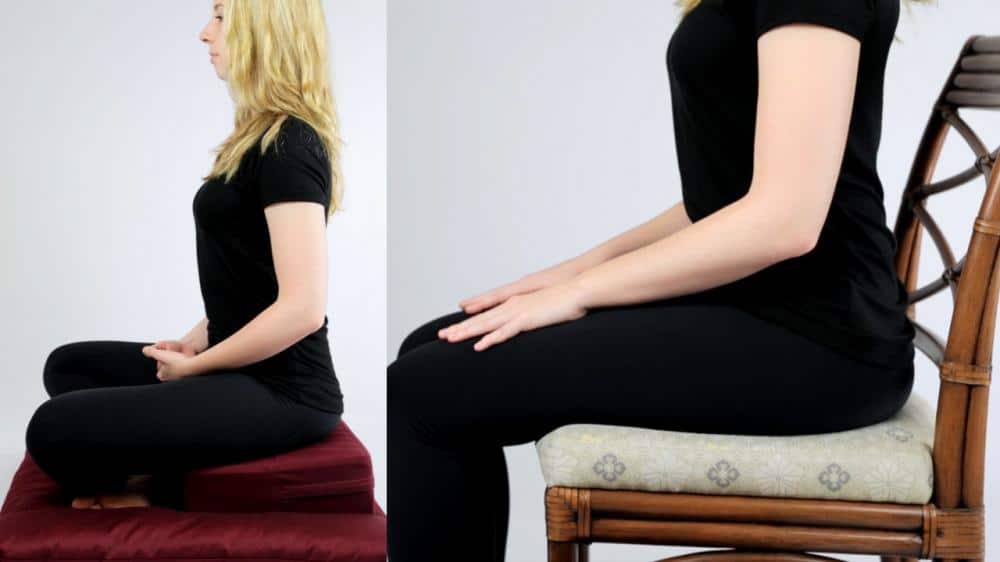The Best Meditation Posture for You
Category: Beginners Guide to Meditation | Meditation Posture | Popular

The best meditation posture for you is, first and foremost, the one you can settle into and sustain. Most people meditate while seated on a cushion, meditation bench, or chair. When this is not physically possible, practicing while standing or lying down are do-able. Walking meditation is popular too, especially as a way to take a mindful break from sitting.
When we think of the proper meditation posture, images of the Buddha or of a super-supple yoga instructor sitting in a full lotus spring to mind. They always look blissful and comfortable, don’t they? Indeed with adequate training, good knees and a strong back, many people are able to manage the full or half lotus posture. They find that it enhances their ability to remain focused and relaxed during practice. This is because there is a close connection between what’s going on in the body and what’s going on in the mind.
Good news: you don’t have to spend hours in a full lotus to reap the benefits of mindfulness. Whatever posture you choose, here are some pointers that can help optimize your practice.
Watch Your Back
In his Mindworks M7 guided meditation series, mindfulness teacher Bart Mendel explains how you should sit for meditation: “Keep your back straight, hands on your thighs, shoulders back so you open your chest, eyes open gazing slightly down, breathing normally.”
Indeed, your back should be as straight as it comfortably can be. Some instructions suggest that you imagine taking hold of some hair towards the back of your scalp and pull it upwards as if a gentle giant were helping straightening your posture (if you have enough hair, that is) from above. See what it feels like to be aligned.
Energy circulates up and down the spine and radiates into the other parts of the body. If you are able to maintain a straight back during meditation, good energy flow is facilitated and this can help reduce agitation and drowsiness.
Points of meditation posture to explore
If you are sitting on the floor – cross-legged, lotus, kneeling posture: there are many options for the legs. It is generally recommended that the knees be slightly lower than the hips, though there are exceptions to the rule. If you are seated on a chair, place your feet flat on the floor without crossing your legs, and if possible sit towards the front of your chair without leaning back.
Your hands can rest on your thighs near the knees, or in your lap, or in the “meditation posture:” one hand settled on the other, with the tips of the thumbs touching. Your shoulders should be open so that the breath flows naturally in and out of your lungs. Tucking the chin in a little bit will promote that alignment we mentioned when we looked at the back.
Breathe through your nose if you can. Your mouth can be closed or just a bit open. By directing your attention to your belly, chest, nostrils, etc., you should be able to feel the flow of your breath as it enters and leaves the body.
Finally, we recommend that you meditate with your eyes open or half open. Many people find that keeping their eyes half-open and gently directing their gaze down in front of them helps quiet the mind and keep it focused.
Our Take Your Seat video will lead you through the main points and get you settled.

Find a meditation rhythm, naturally!
As you focus your attention on the breath, it will naturally find its own rhythm. No need to try to modify it. As you meditate, you may become aware of discomfort in the body or maybe your legs are falling asleep. Feel free to shift and move your meditation posture as necessary but try to maintain awareness. Other times, you’ll find yourself aware of physical sensations that you can work with without moving – that itchy spot on the bridge of your nose or the tension in your jaw or shoulders. See what happens when you take note, relax and release the tension, and go back to the breath.
Mindfulness is all about seeing what works for you. For more information, check out our online course Meditation Essentials. With the right seat, posture, attitude, and instructions, you’ve got everything you need to get you started and keep you going.






